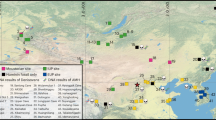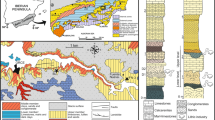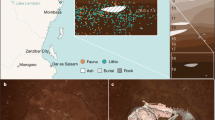Abstract
It is generally believed that, during the middle Pleistocene in Africa, archaic Homo sapiens arose from Homo erectus and Acheulian tool industries were replaced by Middle Stone Age industries. The details of these transitions are poorly known because of the paucity of associated hominid, faunal and archaeological remains in datable contexts1,2. We describe here Lainyamok, a new middle Pleistocene site. Fossil material includes three hominid teeth attributed to Homo sp. and a diverse fauna represented by unusually complete skeletal material. Acheulian artefacts are found both within bone clusters and thinly scattered throughout the site. The clustering of associated or articulated partial skeletons and artefacts suggests that Lainyamok may preserve evidence of the killing or butchering of individual, small- to medium-sized animals. Such sites have not previously been identified in the Pleistocene.
This is a preview of subscription content, access via your institution
Access options
Subscribe to this journal
Receive 51 print issues and online access
$199.00 per year
only $3.90 per issue
Buy this article
- Purchase on Springer Link
- Instant access to full article PDF
Prices may be subject to local taxes which are calculated during checkout
Similar content being viewed by others
References
Butzer, K. & Isaac, G. Ll. (eds) After the Australopithecines (Mouton, The Hague, 1975).
Rightmire, G. P. in Current Argument on Early Man (ed. Konigsson, L.-K. ), 70–85 (Pergamon, Oxford, 1980).
Pickford, M. Geol. Dept Rep. (National Museums of Kenya, Nairobi, 1979).
Eugster, H. P. Contrib. Miner. Spec. Pap. 3, 215–235 (1969).
Baker, B. H. Geol. Surv. Kenya Rep. 42, (1958).
Crossley, R. J. geol. Soc. Lond. 36, 393–405 (1979).
Baker, B. H., Williams, L. A. J., Miller, J. A. & Fitch, F. J. Tectonophysics 11, 191–215 (1971).
Fairhead, J. D., Mitchell, J. G. & Williams, L. A. J. Nature 238, 66–69 (1972).
Baker, B. H. & Mitchell, J. G. J. geol. Soc. Lond. 132, 467–484 (1976).
Eugster, H. P. in Hypersaline Brines and Evaporitic Environments (ed. Nissenbaum, A.) 195–232 (Elsevier, Amsterdam, 1981).
Baker, B. H. Geol. Surv. Kenya Rep. 61, (1963).
Voorhies, M. R. Contr. Geol. Spec. Pap. 1, (1969).
Behrensmeyer, A. K. Mus. comp. Zool. Bull. 146, 473–578 (1975).
Gifford, D. P. thesis, Univ. California, Berkeley (1977).
Isaac, G. Ll. Olorgesailie; Archaeological Studies of a Middle Pleistocene Lake Basin in Kenya (University of Chicago Press, 1977).
Shipman, P., Bosler, W. & Davis, K. L. Curr. Anthrop. 22(3), 257–268 (1981).
Yellen, J. E. in Experimental Archaeology (eds Ingersoll, D., Yellen, J. E. & MacDonald, W.) 271–331 (Columbia University Press, 1977).
Woodburn, J. in Man the Hunter (eds Lee, R. B. & DeVore, I.) 49–55 (Aldine, Chicago, 1968).
Day, M. R. Guide to Fossil Man (University of Chicago Press, 1977).
Weidenreich, F. Palaeont. sinica D, 1 (1937).
Author information
Authors and Affiliations
Rights and permissions
About this article
Cite this article
Shipman, P., Potts, R. & Pickford, M. Lainyamok, a new middle Pleistocene hominid site. Nature 306, 365–368 (1983). https://doi.org/10.1038/306365a0
Received:
Accepted:
Issue Date:
DOI: https://doi.org/10.1038/306365a0
This article is cited by
-
Uplift of the roof of africa and its bearing on the evolution of mankind
Human Evolution (1990)
-
The Kapthurin Formation revisited
African Archaeological Review (1990)
Comments
By submitting a comment you agree to abide by our Terms and Community Guidelines. If you find something abusive or that does not comply with our terms or guidelines please flag it as inappropriate.



